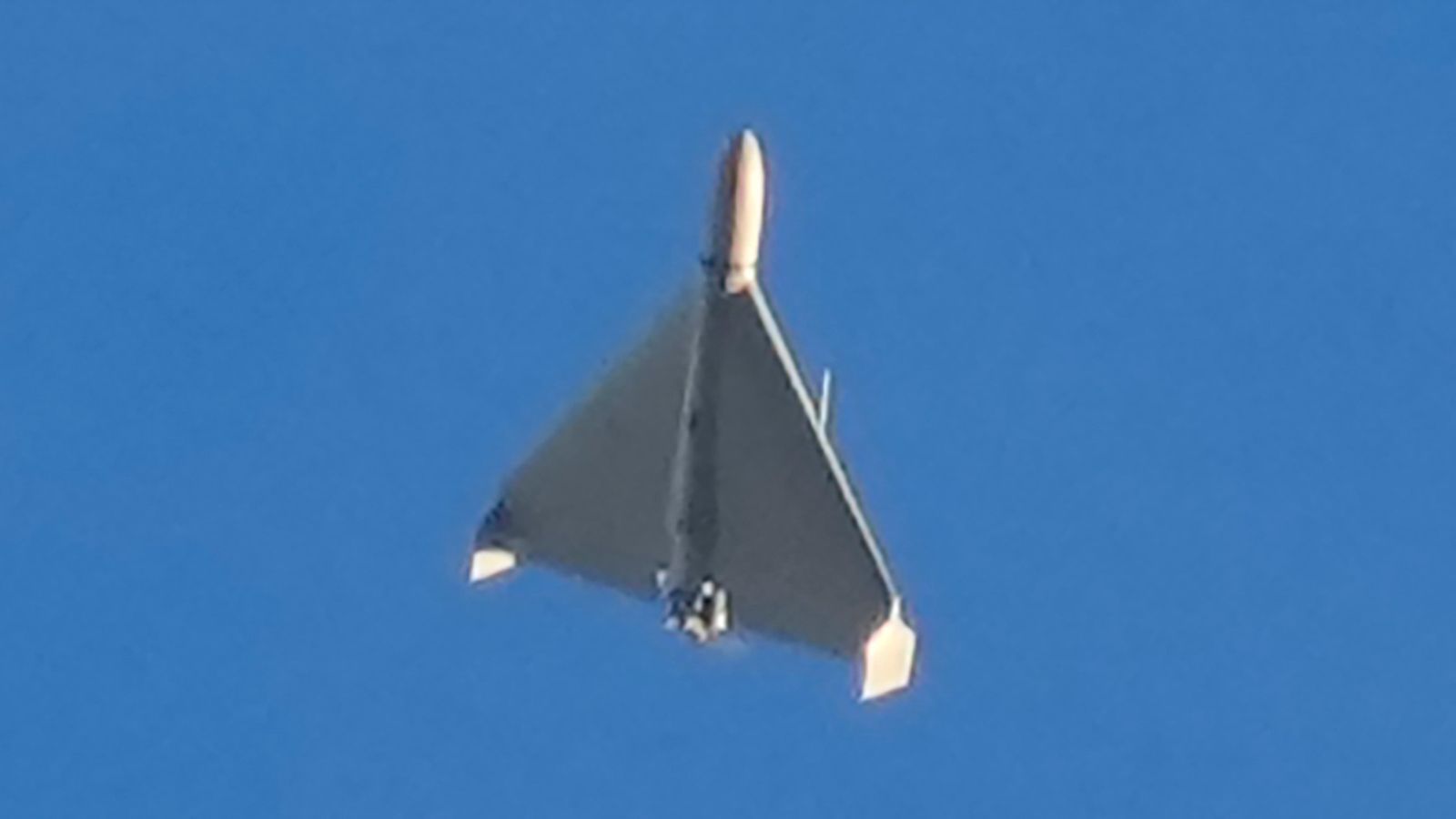Iran has developed a new attack drone for Russia’s war in Ukraine and appears close to providing Moscow with surface-to-surface missiles, an informed security source has claimed.
The Shahed-107 was described as an “explosive and reconnaissance” unmanned aerial vehicle (UAV), possibly fitted with technology to seek out high-value battlefield targets such as British and American multiple-launch rocket systems used by Ukrainian forces.
The source told Sky News “a few units” of the specially-designed drone may have been offered to Russia in a deal estimated to be worth more than $2m (£1.6m).
This reflects “the significant force design work Iran is engaged in to support Russia’s interests regarding Ukraine“, the source said.
Ukraine and its western allies have previously accused Tehran of supplying Moscow with hundreds of one-way attack drones known as the Shahed-131 and Shahed-136 – dubbed “suicide drones” because they fly into targets and explode on impact.
Russia uses a combination of drone and missile strikes to try to penetrate Ukraine’s western-backed air defences in waves of deadly attacks against civilian and military targets across the country that have intensified in recent days.
The security source said the new Shahed-107 drone was from the Shahed-101 family of unmanned aerial vehicles, with a V-shaped tail.
About 2.5 metres long and with a wingspan of three metres, the UAV can be launched from a vehicle and is estimated to have a range of up to 1,500km (932 miles), the source said.
It is thought to be fitted with a livestreaming transmitter for transmitting video. Such reconnaissance capabilities mean the drone could be used to identify targets on Ukraine’s frontline for other UAVs or weapons systems to hit.
The security source claimed that Iranian security forces conducted a trial with the Russians at an airbase in central Iran that included the Shahed-107 and the Shahed-136 drones.
Russia’s defence ministry and Iran’s foreign ministry have not yet responded to a request for comment.
In September, Iran’s president denied his country had sent drones or other weapons to Russia for use in Ukraine.
“We are against the war in Ukraine,” President Ebrahim Raisi was quoted as saying on a sidelines of the UN General Assembly in New York.
But Sky News last year revealed a purported arms contract that offered the first hard evidence that Iran had sold ammunition to Russia for its war effort.
‘Huge concerns’ for Ukraine
A Ukrainian source said the claim about the development of a new type of drone was “likely true”.
“We have huge concerns about possible supplies of the mentioned types of the drones,” the source said.
The Russian “offensive relies a lot on the Iranian drones, constantly modernising them. They try to make them faster to force Ukrainian defence forces to use more expensive air defence systems”.
Read more:
Russia and Ukraine are both running out of munitions
Vladimir Putin vows to back soldiers who ‘defend’ Russia
The Ukrainian source said Russia is now able to assemble the Shahed-136 systems itself at a facility in the Tatarstan region, 500 miles east of Moscow.
“The manufacturing capacity [by] September 2025 should be around 4,000 pieces per year,” the source said.
If confirmed, defence experts said the development by Iran of a new drone would underline its growing military manufacturing capabilities and its importance to Russia’s war effort.
Michael Clarke, a visiting professor at King’s College London, warned: “But the political costs to Iran are really quite great because this puts Iran firmly in the camp of those who are trying to overthrow violently the current international system.”
The partnership would become even more significant with the delivery of Iranian surface-to-surface ballistic missiles to Russia – far more lethal and harder to shoot down than drones.
“From reliable information it seems that Iran and Russia have renewed the weapons deal and Russia is expecting to receive, sometime soon, precision surface-to-surface missile systems,” the informed security source said.
This includes missiles with a range longer than 300km (186 miles).
A US official was quoted in American media earlier this month also saying that Iran is preparing to start providing short-range ballistic missiles to Russia.
The Iranian regime, amid the threat of further sanctions and international isolation, had previously held off from offering up its vast stockpiles of precision-guided missiles since the start of Russia’s full-scale invasion of Ukraine in February 2022.
However, its calculations appear to be changing following the expiry last October of UN Security Council sanctions designed to curb Iran’s ballistic missile programme as part of a major 2015 nuclear agreement with world powers that has since unravelled.
The apparent shift in policy also comes as war in the Middle East diverts western attention away from Ukraine even as Russia’s offensive on the ground re-intensifies.
The Ukrainian source said the transfer of Iranian missiles would help Russia to repeat a campaign of terror launched last winter against Ukraine’s energy infrastructure, which caused extended blackouts across the country at a time of freezing temperatures.
The kind of systems could include Tehran’s shorter-range tactical Ababil missiles or its Fateh collection, which have a slightly longer range of between 300 km to 700 km (186 miles to 435 miles), according to Fabian Hinz, a research fellow at the International Institute for Strategic Studies (IISS) think-tank.
“They could hit targets in the entirety of Ukraine with accuracy in that case,” he told Sky News.
Ballistic missiles are harder to intercept so would force the Ukrainian military to use more of its finite supply of US-provided Patriot air defence missiles, which have a limited range.
The Patriot batteries “cannot protect every spot in Ukraine against ballistic missile attacks”, Mr Hind said.
“So the Russians could leverage that situation to cause quite a lot of destruction when it comes to civilian infrastructure, for example.”
In return, Iran would likely be seeking cash and military technology from Russia.
Mr Clarke, the visiting professor, said the anticipated delivery of missiles signalled that Iran has “decided strategically, I think, to throw in their lot with Russia and by implication, also China, because they see a realignment of world politics taking place before our eyes, and they think that this will help put them on the side that will eventually prevail”.







